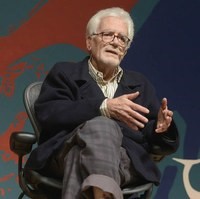São Paulo, 1933 – Rio de Janeiro (Brasil), 2014
By Afrânio Mendes Catani
Brazilian filmmaker, director, and screenwriter. He worked as a journalist from 1953 to 1957. From 1958, he studied at the Institut des Hautes Études Cinématographiques (IDHEC) in France. Returning to Brazil, he joined the Centro Popular de Cultura (CPC) of the União Nacional dos Estudantes (UNE) and worked as production manager for the anthology film Cinco vezes favela (1962). He settled in Rio de Janeiro from then on and, that same year, was part of the UNE volante, traveling across the country documenting social problems in various regions. In the state of Paraíba, he filmed a rally featuring Elisabeth Teixeira, widow of João Pedro Teixeira, a peasant leader murdered by local landowners. This formed the nucleus of Cabra marcado para morrer, a documentary about the land struggle in Brazil. Before filming was completed, in 1964, the military coup occurred: filming was interrupted, several peasants involved in the film were arrested, the crew was forced to flee, and equipment was confiscated. Some of the filmed material was saved by being sent to a lab in Rio de Janeiro. Coutinho then worked as co-screenwriter on A falecida (Leon Hirszman, 1965), Garota de Ipanema (Hirszman, 1967), Os condenados (Zelito Vianna, 1974), Lição de amor (Eduardo Escorel, 1975), and Dona Flor e seus dois maridos (Bruno Barreto, 1976). He wrote and directed his first feature film, the comedy O homem que comprou o mundo (1969). He then made Faustão (1971), a cangaço-themed film. That same year, he returned to journalism, even writing reviews for Jornal do Brasil.
From 1975 to 1984, he worked at Rede Globo Television on the program “Globo Repórter” (director, editor, and writer), learning to make documentaries. He resumed production of Cabra marcado para morrer, released in 1984, gaining national and international acclaim. The film marked the reunion between the director and the people of the region almost two decades later. He dedicated part of the 1980s to independent documentary video. He returned to cinema with Fio da memória (1991), addressing African culture, and years later began making feature films shot on video and finished on film. Thus, he created Santo forte (1999), about the religious experiences of residents in a Rio de Janeiro favela, and Babilônia 2000 (2001), about what the residents of Morro da Babilônia expected with the arrival of the new millennium. Edifício Master (2002) focused on the daily lives of residents of a building in Copacabana, Rio de Janeiro; Peões (2004) focused on trade unionists from the 1970s and 1980s, colleagues of President Luiz Inácio Lula da Silva; O fim e o princípio (2005), filmed in the Paraíba backlands, collected testimonies about the lives of the region’s inhabitants. His last work was the documentary A Família de Elisabeth Teixeira (2014).





